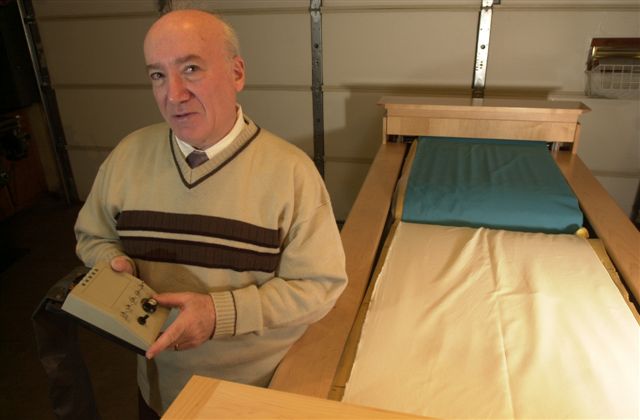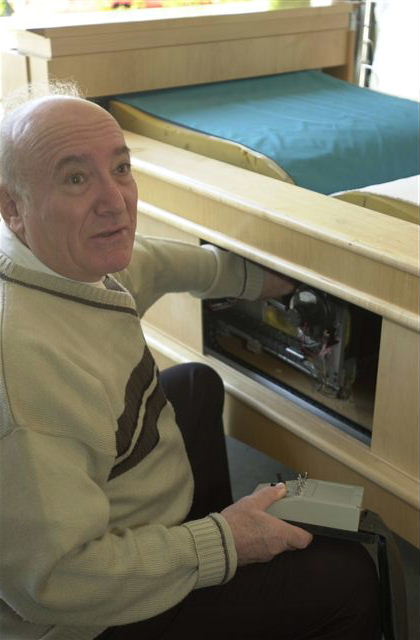

and his bed that changes the sheets without moving the sleeper.
TUE NAM TON/STAFF
that allow access anywhere beneath the patent.
TUE NAM TON/STAFF
Home > Press Coverage > Inventor makes bed...
By Valerie Dana Levitt
STAFF WRITER

|

| |
|
ALAMEDA INVENTOR GEORGE KHAIT and his bed that changes the sheets without moving the sleeper. TUE NAM TON/STAFF |
KHAIT DEMONSTRATES THE SLIDING DOORS that allow access anywhere beneath the patent. TUE NAM TON/STAFF |
An old episode of Laverne and Shirley plays on George Khait's TV screen.
Laverne, a hospital worker, is changing the linens on an unconscious man's bed. She tugs on the material. The man rolls this way and that. She straddles him. She pulls. She pushes. She slides under the bed. Shirley comes to her aid. The two end up positioned like contortionists with the man sandwiched between them. The scene is hilarious. Or is it?
George Khait, an Alameda mechanical engineer and engineering consultant learned the realities of patient care and comfort when his 80 year old mother suffered a stroke.
Distressed by the pain and suffering his mother endured, and surprised at the time and difficulty caregivers face daily, Khait designed a bed that changes linens without lifting, turning or moving the patient. "When my mother was sick I saw the suffering of bedridden patients and the elderly," Khait said. "I started thinking about how to attack this problem."
He came up with the idea for the bed and discussed it with his friend, Dr. Sam Rose.
"Sam Rose requested a protoype to see that it wasn't a fairytale and I was forced to build a tiny bed," Khait said.
He quit his job and went to work on the project.
He showed his initial doll sized metal prototype to Rose.
"He looked at me and said 'You know George, you're not as stupid as you look.' "
Rose gave Khait his first financial support and promised more in the future. Sadly, the doctor passed away suddenly before the bed was ready to be marketed.
Khait has spent three years on the project and has produced three phototypes.
His daughter Julia said her father locked himself in the garage for a few years and came out with his brainchild.
"This one does most of the things I want it to do," Khait said.
The bed's mattress has two pieces that are controlled by a switch and move to create free space anywhere beneath the patient. Changing linens, Khait said, is the simplest thing. It takes only seconds. The caregiver lines up standard sheets on the bed's cartridge and flips a switch.
The patient gets a gentle massage as the new sheet moves into place. That's not all. The bed's wooden frame has sliding doors that allows access to the patient's underside. Caregivers can perform additional treatments without moving the patient.
With open space under the mattress the bed provides an in bed portable toilet, bathing facilities, assistance in diaper changing, assistance in the application of theraputic procedures, the ability to X-ray any part of the body without moving the patient from the bed, treating and preventing bedsores by providing regular relief to pressure points, and more.
Khait said over $100 billion is spent annually to provide health-care services for bedridden individuals in the U.S. Caring for the bedridden is one of the country's fastest- growing occupations. It is also one of the most dangerous. Khait said of the 20 fastest-growing careers, nursing homes have the highest rate of occupational injuries. Many of these occur while lifting moving and turning patients.
Khait said his invention, the Uniservice bed, will reduce health care costs, save time and energy and reduce injuries to both patients and staff.
Originally from the Ukraine, Khait came to Alameda 17 years ago with the wife Janna and his daughter, Julia, 21. He now runs Acculine International Corporation from his home.
Khait holds 18 patents for other inventions including an engineering template for drawing circles, a device that quickly removes crowns from teeth, and a camera part that records the date and time a photograph was taken on film.
Khait's photographic labeling invention was recognised as one of the top 10 percent inventions of the year in the 1991 edition of "Leaders in American Innovation" and in the 1992-1993 edition of "Who's Who of American Inventors."
Khait recently demonstrated the bed on Channel 2's 10 O'clock news show. The working prototype UniServBed has a patent pending in the United States.
Khait said he is ready to build pre-production prototypes. He is looking for investors a stragetic partner, or humanitarian support to help him.
"The bed is a gift to humanity. I hope to bring it to those who need it," he said.
(From the Alameda Journal, April 11, 2002)